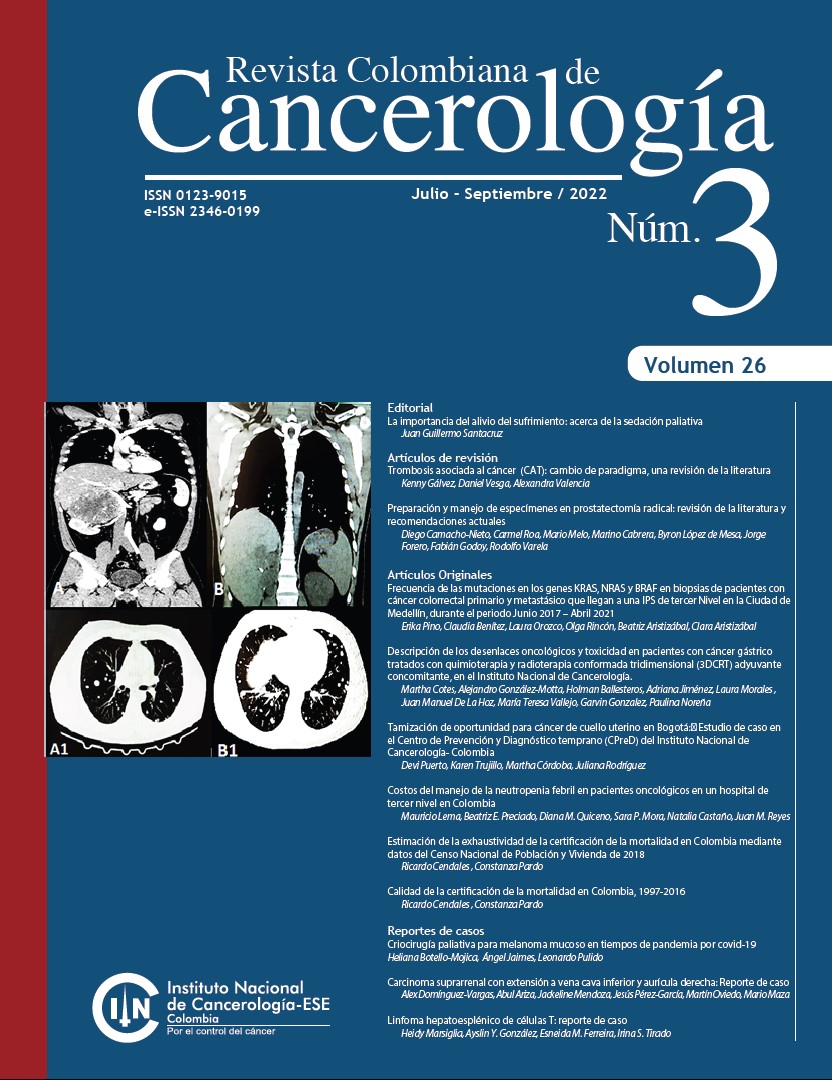Preparation and handling of radical prostatectomy specimens: review of the literature and current recommendations
DOI:
https://doi.org/10.35509/01239015.813Keywords:
Prostate cancer, prostatectomy, specimen handling, pathology, Gleason score.Abstract
Radical prostatectomy is the standard surgical management for patients with localized prostate cancer, once this procedure has been carried out, all the tissue samples obtained (prostate, seminal vesicles and lymph nodes) are taken for histopathological analysis. The result of the pathological study is the most important parameter in cancer treatment, it will determine adjuvant treatments and the rates of biochemical recurrence-free survival, cancerspecific and global survival. Given the clinical importance of adequately processing the specimens, an adequate pathology report, there are multiple guidelines that summarize the way of handling and reporting radical prostatectomy specimens.
However, recent literature considers details of the processing of the samples and the reporting of findings that havea significant impact on adverse cancer outcomes (for example: marking of the prostate, characteristics of positive margins, focal extra prostatic extension, pT2 sub classification, pT2+ concept, lymph node characteristics, among others). In Colombia there is no consensus about which of the international guidelines are more adapted to the characteristics of our environment, and the details that are mentioned in recent literature are not systematically
taken into account in local reports.
In this scenario of academic absence, the following article compiles a narrative review of all the existing information
about the processing and reporting of the samples generated in a radical prostatectomy. Once all the literature was obtained, a critical analysis was carried out between the Oncology Urology and Pathology of an oncology center of reference at the national level (National Cancer Institute, Colombia) in order to establish reproducible and applicable recommendations
References
2. Ministerio de la Protección Social. Guía de práctica clínica ( GPC ) para la detección temprana , seguimiento y rehabilitación del cáncer de próstata. 2013.
3. Samaratunga H, Montironi R, True L, Epstein JI, Griffiths DF, Humphrey PA, et al. International society of urological pathology (ISUP) consensus conference on handling and staging of radical prostatectomy specimens. working group 1: Specimen handling. Mod Pathol [Internet]. 2011;24(1):6–15. Available from: http://dx.doi.org/10.1038/modpathol.2010.178
4. Srigley JR, Humphrey PA, Amin MB, Chang SS, Egevad L, Epstein JI, et al. Protocol for the examination of specimens from patients with carcinoma of the prostate gland. Arch Pathol Lab Med. 2020;133(10):1568–76.
5. (ICCR) IC on CR. Prostate Cancer Histopathology Reporting Guide Radical Prostatectomy Specimen. 2017;(August):1–2.
6. Sewell C. Standards and Datasets for Reporting Cancers Dataset for histopathology reports for prostatic carcinoma. R Coll Pathol. 2016;(261035):1–31.
7. Dash A, Maine IP, Varambally S, Shen R, Chinnaiyan AM, Rubin MA. Changes in differential gene expression because of warm ischemia time of radical prostatectomy specimens. Am J Pathol. 2002;161(5):1743–8.
8. Best S, Sawers Y, Fu VX, Almassi N, Huang W, Jarrard DF. Integrity of Prostatic Tissue for Molecular Analysis After Robotic-Assisted Laparoscopic and Open Prostatectomy. Urology. 2007;70(2):328–32.
9. Egevad L. Handling of radical prostatectomy specimens. Histopathology. 2012;60(1):118–24.
10. Start RD, Layton CM, Cross SS, Smith JHF. Reassessment of the rate of fixative diffusion. J Clin Pathol. 1992;45(12):1120–1.
11. Harvey CJ, Pilcher J, Richenberg J, Patel U, Frauscher F. Applications of transrectal ultrasound in prostate cancer. Br J Radiol. 2012;85(SPEC. ISSUE 1):3–17.
12. Cohen MB, Soloway MS, Murphy WM. Sampling of radical prostatectomy specimens: How much is adequate? Am J Clin Pathol. 1994;101(3):250–2.
13. Duffield AS, Epstein JI. Detection of cancer in radical prostatectomy specimens with no residual carcinoma in the initial review of slides. Am J Surg Pathol. 2009;33(1):120–5.
14. Gleason D. Classification of prostatic carcinomas. Cancer Chemother reports. 1966;50(3):125–8.
15. Epstein JI, Amin MB, Reuter VE, Humphrey PA. Contemporary gleason grading of prostatic carcinoma. Am J Surg Pathol. 2017;41(4):e1–7.
16. Epstein JI, Egevad L, Amin MB, Delahunt B, Srigley JR, Humphrey PA. The 2014 international society of urological pathology (ISUP) consensus conference on gleason grading of prostatic carcinoma definition of grading patterns and proposal for a new grading system. Am J Surg Pathol. 2016;40(2):244–52.
17. Trock BJ, Guo CC, Gonzalgo ML, Magheli A, Loeb S, Epstein JI. Tertiary Gleason Patterns and Biochemical Recurrence After Prostatectomy: Proposal for a Modified Gleason Scoring System. 2015;182(4):1364–70.
18. Pierorazio PM, Walsh PC, Partin AW, Epstein JI. Prognostic Gleason grade grouping: Data based on the modified Gleason scoring system. BJU Int. 2013;111(5):753–60.
19. Chirag Doshi, Michael Vacchio, Kristopher Attwood, Christine Murekeyisoni, Diana C. Mehedint, Shervin Badkhshan1, Gissou Azabdaftari, Norbert Sule, Khurshid A. Guru, James L. Mohler and ECK. Clinical Significance of Prospectively Assigned Gleason Tertiary Pattern 4 in Contemporary Gleason Score 3+3 =6 Prostate Cancer. Prostate. 2017;76(8):715–21.
20. Epstein JI, Matoso A. Survival Guide to Prostate Pathology. 1st ed. Innovative Science Press; 2020. 145–177 p.
21. Sobin LH, Fleming ID. TNM classification of malignant tumors, Fifth edition (1997). Cancer. 1997;80(9):1803–4.
22. L.H. Sobin, M.K. Gospodarowicz CW. TNM Classification of Malignant Tumours. 2009. 368 p.
23. Van Der Kwast TH, Amin MB, Billis A, Epstein JI, Griffiths D, Humphrey PA, et al. International society of urological pathology (ISUP) consensus conference on handling and staging of radical prostatectomy specimens. working group 2: T2 substaging and prostate cancer volume. Mod Pathol [Internet]. 2011;24(1):16–25. Available from: http://dx.doi.org/10.1038/modpathol.2010.156
24. Paner GP, Stadler WM, Hansel DE, Montironi R, Lin DW, Amin MB. Updates in the Eighth Edition of the Tumor-Node-Metastasis Staging Classification for Urologic Cancers. Eur Urol [Internet]. 2018;73(4):560–9. Available from: http://dx.doi.org/10.1016/j.eururo.2017.12.018
25. Stamey TA, McNeal JE, Yemoto CM, Sigal BM, Johnstone IM. Biological determinants of cancer progression in men with prostate cancer. J Am Med Assoc. 1999;281(15):1395–400.
26. Sakai I, Harada KI, Kurahashi T, Yamanaka K, Hara I, Miyake H. Analysis of differences in clinicopathological features between prostate cancers located in the transition and peripheral zones. Int J Urol. 2006;13(4):368–72.
27. Sakai I, Harada KI, Hara I, Eto H, Miyake H. A comparison of the biological features between prostate cancers arising in the transition and peripheral zones. BJU Int. 2005;96(4):528–32.
28. Magi-Galluzzi C, Evans AJ, Delahunt B, Epstein JI, Griffiths DF, Van Der Kwast TH, et al. International society of urological pathology (ISUP) consensus conference on handling and staging of radical prostatectomy specimens. working group 3: Extraprostatic extension, lymphovascular invasion and locally advanced disease. Mod Pathol [Internet]. 2011;24(1):26–38. Available from: http://dx.doi.org/10.1038/modpathol.2010.158
29. Epstein JI, Carmichael M, Partin AW, Walsh PC. Is tumor volume an independent predictor of progression following radical prostatectomy? A multivariate analysis of 185 clinical stage B adenocarcinomas of the prostate with 5 years of followup. J Urol. 1993;149(6):1478–81.
30. Epstein JI. Pathologic assessment of the surgical specimen. Urol Clin North Am. 2001;28(3):567–94.
31. Wheeler TM, Dillioglugil Ö, Kattan MW, Arakawa A, Soh S, Suyama K, et al. Clinical and pathological significance of the level and extent of capsular invasion in clinical stage T1-2 prostate cancer. Hum Pathol. 1998;29(8):856–62.
32. Ming-Tse Sung, MD,*wz Haiqun Lin, MD, PhD, y Michael O. Koch, MD, J Darrell D. Davidson, MD, PhD,* and Liang Cheng M. Radial distance of extraprostatic extension measured by an ocular micrometer is an independent predictor of prostate-specific antigen recurrence: A new proposal for the substaging of pT3a prostate cancer [3]. Am J Surg Pathol. 2008;32(2):337–8.
33. Ng J, Mahmud A, Bass B, Brundage M. Prognostic significance of lymphovascular invasion in radical prostatectomy specimens. BJU Int. 2012;110(10):1507–14.
34. Ferrari MK, McNeal JE, Malhotra SM, Brooks JD. Vascular invasion predicts recurrence after radical prostatectomy: Stratification of risk based on pathologic variables. Urology. 2004;64(4):749–53.
35. Tan PH, Cheng L, Srigley JR, Griffiths D, Humphrey PA, Van Der Kwast TH, et al. International society of urological pathology (ISUP) consensus conference on handling and staging of radical prostatectomy specimens. Working group 5: Surgical margins. Mod Pathol [Internet]. 2011;24(1):48–57. Available from: http://dx.doi.org/10.1038/modpathol.2010.155
36. Emerson RE, Koch MO, Daggy JK, Cheng L. Closest distance between tumor and resection margin in radical prostatectomy specimens: Lack of prognostic significance. Am J Surg Pathol. 2005;29(2):225–9.
37. Poulos CK, Koch MO, Eble JN, Daggy JK, Cheng L. Bladder neck invasion is an independent predictor of prostate-specific antigen recurrence. Cancer. 2004;101(7):1563–8.
38. Eastham JA, Kuroiwa K, Ohori M, Serio AM, Gorbonos A, Maru N, et al. Prognostic Significance of Location of Positive Margins in Radical Prostatectomy Specimens. Urology. 2007;70(5):965–9.
39. Babaian RJ, Troncoso P, Bhadkamkar VA, Johnston DA. Analysis of clinicopathologic factors predicting outcome after radical prostatectomy. Cancer. 2001;91(8):1414–22.
40. Dengfeng Cao, MD, PhD,* Adam S. Kibel, MD, w Feng Gao, MD, PhD, z Yu Tao, MD, z and Peter A. Humphrey, MD P. The gleason score of tumor at the margin in radical prostatectomy is predictive of biochemical recurrence. J Urol. 2011;185(2):516–7.
41. Kates M, Sopko NA, Han M, Partin AW, Epstein JI. Importance of Reporting the Gleason Score at the Positive Surgical Margin Site: Analysis of 4,082 Consecutive Radical Prostatectomy Cases. J Urol [Internet]. 2016;195(2):337–42. Available from: http://dx.doi.org/10.1016/j.juro.2015.08.002
42. Berney DM, Wheeler TM, Grignon DJ, Epstein JI, Griffiths DF, Humphrey PA, et al. International society of urological pathology (ISUP) consensus conference on handling and staging of radical prostatectomy specimens. working group 4: Seminal vesicles and lymph nodes. Mod Pathol [Internet]. 2011;24(1):39–47. Available from: http://dx.doi.org/10.1038/modpathol.2010.160
43. Potter SR, Epstein JI, Partin AW. Seminal vesicle invasion by prostate cancer: prognostic significance and therapeutic implications. Rev Urol [Internet]. 2000;2(3):190–5. Available from: http://www.ncbi.nlm.nih.gov/pubmed/16985773%0Ahttp://www.pubmedcentral.nih.gov/articlerender.fcgi?artid=PMC1476128
44. Ohori M, Scardino PT, Wheeler TM. The mecanisms and prognostic significance of seminal vesicle involvement by prostate cancer. Am J Surigcal Pathol. 1993;12(17):1252–61.
45. D’Amico A V., Whittington R, Bruce Malkowicz S, Schultz D, Blank K, Broderick GA, et al. Biochemical outcome after radical prostatectomy, external beam radiation therapy, or interstitial radiation therapy for clinically localized prostate cancer. J Am Med Assoc. 1998;280(11):969–74.
46. Messing E. N+, M0 prostate cancer: Local therapy for systemic disease. Oncol (United States). 2013;27(7).
47. Abdollah F, Sun M, Thuret R, Jeldres C, Tian Z, Briganti A, et al. Lymph node count threshold for optimal pelvic lymph node staging in prostate cancer. Int J Urol. 2012;19(7):645–51.
48. Passoni NM, Fajkovic H, Xylinas E, Kluth L, Seitz C, Robinson BD, et al. Prognosis of patients with pelvic lymph node (LN) metastasis after radical prostatectomy: Value of extranodal extension and size of the largest LN metastasis. BJU Int. 2014;114(4):503–10.
49. Luchini C, Fleischmann A, Boormans JL, Fassan M, Nottegar A, Lucato P, et al. Extranodal extension of lymph node metastasis influences recurrence in prostate cancer: A systematic review and meta-Analysis. Sci Rep. 2017;7(1):1–7.
50. Egevad L, Srigley JR, Delahunt B. International society of urological pathology (ISUP) consensus conference on handling and staging of radical prostatectomy specimens: Rationale and organization. Mod Pathol [Internet]. 2011;24(1):1–5. Available from: http://dx.doi.org/10.1038/modpathol.2010.159
How to Cite
Downloads
Downloads
Published
Issue
Section
License
Copyright (c) 2022 Revista Colombiana de Cancerología

This work is licensed under a Creative Commons Attribution-NonCommercial-NoDerivatives 4.0 International License.
Todos los derechos reservados.





